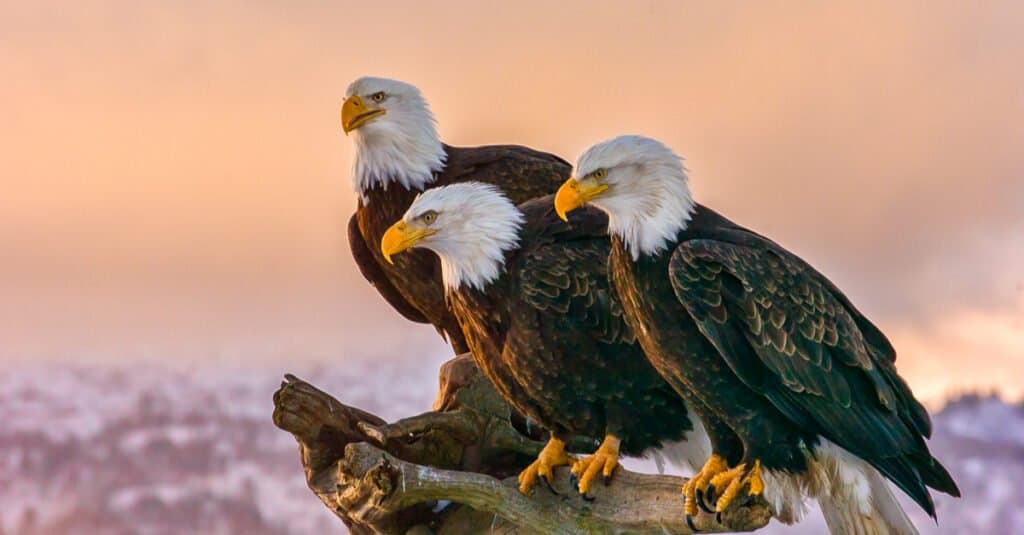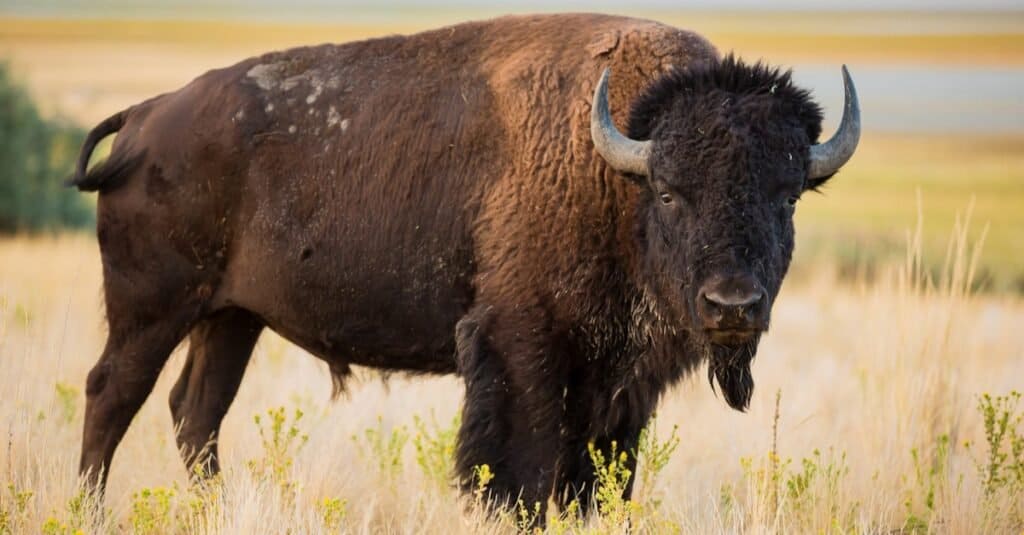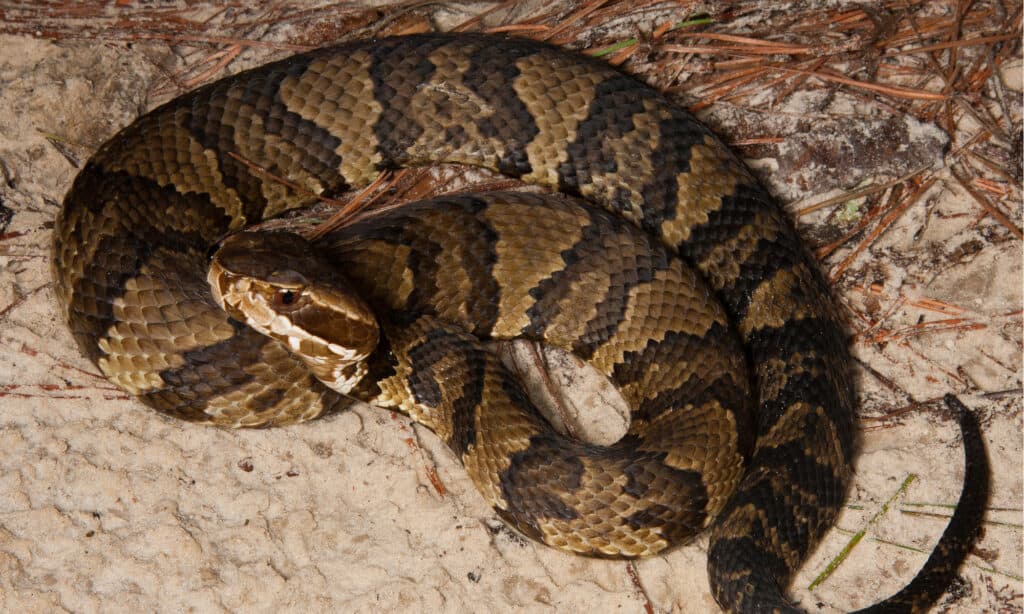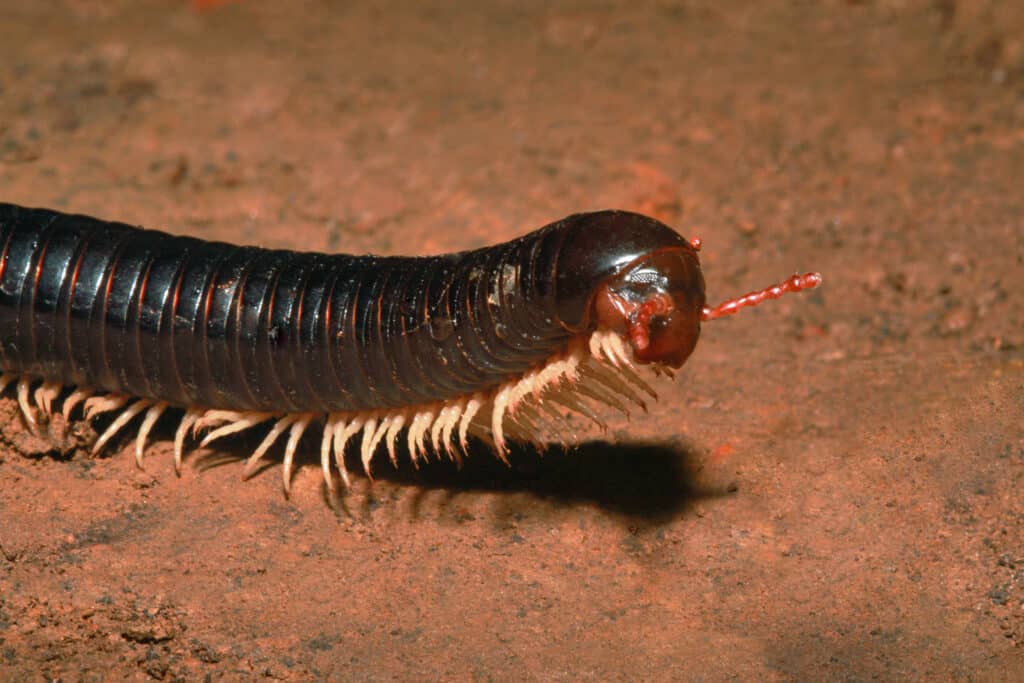Oklahoma’s many geographical zones and damp subtropical climate contribute to its rich biodiversity. Wild animals range from well-known to extraordinary to common. For example, the eastern mole is another Oklahoma native species with outsized digging hands, tiny eyes, and a long nose. The southern flying squirrel glides from tree to tree using a membrane that stretches between their front and back legs on both sides of their body. The little stinkpot turtle is an aquatic turtle named for the species’ organs, which produce foul-smelling chemicals to warn off predators. Citrine forktails are lovely, delicate, golden-colored damselflies.
In addition to a vast variety of smaller creatures, Oklahoma is home to a variety of large animals. We’ll describe five of the largest species below.

The Largest Fish Is the Alligator Gar

The alligator gar is the largest gar in all of North America.
©Cheng Wei/Shutterstock.com
A 254-pound alligator gar was the largest fish ever caught in the state. Gars are called “primitive fishes” or “living fossils” because they retain physical traits from their ancient progenitors, such as a spiral valve gut and the capacity to breathe air and water. Their common name comes from their likeness to American alligators, especially their long, pointed fangs.
The alligator gar is also the largest gar in all of North America. Adult alligator gars, which are the largest gars in North America, commonly weigh about 100 pounds and measure 6 feet in length. But they can get much, much bigger. In fact, the largest documented alligator gar ever documented was caught in Mississippi in 2011. It weighed 327 pounds and was 8 foot 5 inches long!
Adult gars are huge and hefty, with wide heads, short, broad snouts, big, sharp teeth, and two rows of teeth on their upper jaws. They’re brown or olive above and gray or yellow underneath. Their dorsal, anal, and caudal fins are asymmetrical.
The Largest Bird Is the Bald Eagle

The bald eagle is the largest bird in Oklahoma with a wingspan of 8.2 feet.
©FloridaStock/Shutterstock.com
Oklahoma is home to both golden and bald eagles. Though they are similar in size, the bald eagle has a greater wingspan at 8.2 feet compared to the golden eagle’s at 7.5 feet and is generally considered to be the larger bird. Males of both species weigh about 10 pounds, while females of both species can weigh up to 15 pounds.
Adult bald eagles are easy to identify due to their white heads and tails and their dark brown bodies and wings. Juvenile birds don’t develop this distinctive contrasting plumage until they’re about five years old.
Bald eagles primarily eat fish, but they will also hunt waterfowl, seagulls, and mammals. In addition, many of their meals consist of carrion (carcasses from other predators’ kills, roadkill, etc.) and garbage.
Bald eagles are monogamous and mate for life. They prefer to nest in tall conifer trees, but will nest in other types of trees — and even on cliffs, nesting platforms, or cellphone towers — as well. They construct their nests, which measure from 4 to 6 feet in diameter and 3 feet deep, from large sticks and line them with soft materials such as lichen, grass, or seaweed. They tend to return to the same nest every year. This behavior is called nest fidelity. They lay between one and three eggs per year.
The Largest Mammal Is the American Bison

American Bison are the largest land mammal in North America.
©O.S. Fisher/Shutterstock.com
With bulls weighing in at 2,000 pounds and measuring 6 feet tall at the shoulder, American bison are the largest land mammal in North America. They are grazers that forage between 9 and 11 hours a day, consuming approximately 1.6% of their body weight in vegetation. That’s about 24 pounds a day!
Huge herds of bison used to roam America’s open plains and prairies, but now they only live in zoos, parks, and preserves. Oklahoma has large bison herds at the Wichita Mountains Wildlife Refuge, Tallgrass Prairie Preserve, and the Oklahoma Historical Society’s Pawnee Bill Ranch.
Gray wolves, coyotes, and grizzly bears are the bison’s natural predators, but humans were the predator that nearly drove them to extinction. Today, managed herds are rounded up annually for checkups and vaccinations and culling (selective slaughter).
The Largest Snake Is the Cottonmouth

The cottonmouth is a rare semiaquatic viper native to the southeastern United States.
©Nathan A Shepard/Shutterstock.com
Agkistrodon piscivores, also known as the water moccasin or cottonmouth, is a pit viper in the Viperidae family’s Crotaline subfamily. It’s a rare semiaquatic viper native to the southeastern U.S. and the largest Oklahoma snake. The adult has a large body and a lethal bite. It may coil and expose its fangs if threatened. When attacked or mistreated, it will bite. It’s often found in or near shallow, slow-moving lakes, streams, and marshes.
Adults measure greater than 31 inches, with females smaller than males. Adults in one study were 26 to 35 inches long. Average male body weight ranges from 10.32 to 20.44 ounces and female body weight ranges from 7.09 to 8.96 ounces.
Atoka, Bryan, Choctaw, Haskell, Latimer, LeFlore, McCurtain, Pittsburg, and Pushmataha counties have regular sightings. Eastern state sightings are rare. Few, if any, cottonmouths have been found west of Comanche and Osage counties.
The Largest Insect Is the Iron Worm

Common names for
Narceus americanusinclude American giant
millipede
, worm millipede, and iron worm.
©iStock.com/ePhotocorp
There have been 1,178 bug species documented in Oklahoma thus far. The Narceus americanus is a big species of millipede native to eastern North America, including Oklahoma. Common names for this species include American giant millipede, worm millipede, and iron worm. Its range extends from the northern Ottine wetlands of North America all the way down to Georgetown, Texas, on the southern tip of Texas. It has a length of 4 inches, with a virtually cylindrical gray body. It is commonly found in or around decaying wood between March and October.
Sometimes, when threatened, it will curl up and expel a chemical that’s harmful to humans and contains high levels of benzoquinones, which can cause skin and eye irritation. Claims that N. americanus produces hydrogen cyanide are false. But it does squirt a substance known as millipede burn, which causes a temporary and painless browning of the skin.
Summary of the 5 Largest Animals in Oklahoma, and Where You’ll Find Them
Here’s a recap of the five biggest animals found in Oklahoma that we took a look at.
| Number | Animal | Category | Size |
|---|---|---|---|
| 1 | Alligator Gar | Largest Fish | Weigh about 100 pounds and measure 6 feet in length |
| 2 | Bald Eagle | Largest Bird | Wingspan at 8.2 feet; males weigh about 10 pounds; females weigh up to 15 pounds |
| 3 | American Bison | Largest Mammal | Weigh 2,000 pounds and measure 6 feet tall at the shoulder |
| 4 | Cottonmouth | Largest Snake | More than 31 inches long (females are smaller than males); Average male weight: 10.32-20.44 ounces; female weight: 7.09-8.96 ounces |
| 5 | Iron Worm | Largest Insect | 4 inches long |
The photo featured at the top of this post is © iStock.com/Jillian Cooper
Sources
- Wildlife Department, Available here: https://www.wildlifedepartment.com/wildlife/field-guide/mammals
- Wildlife Department, Available here: https://www.wildlifedepartment.com/
- Texas Parks & Wildlife, Available here: https://tpwd.texas.gov/education/resources/resources/lesson-plans/terrestrial-ecology/bison/learning-about-bison-classroom-activities
- National Park Service, Available here: https://www.nps.gov/articles/15-facts-about-bison.htm
Thank you for reading! Have some feedback for us? Contact the AZ Animals editorial team.






